The Intel Broadwell Desktop Review: Core i7-5775C and Core i5-5675C Tested (Part 1)
by Ian Cutress on June 2, 2015 7:45 AM EST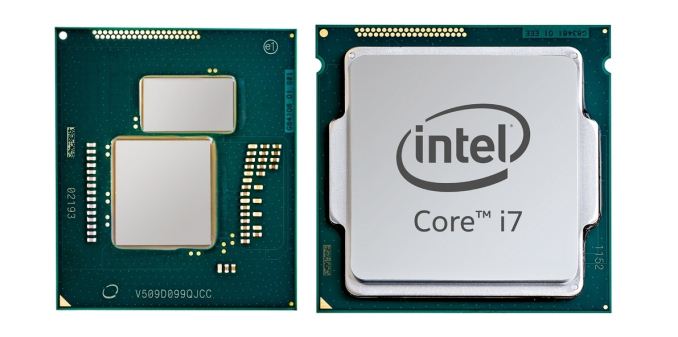
On almost all PC technology forums, it is hard to escape users talking about what Intel’s next processor lineup will be. Due to initial yield issues in Intel’s 14nm node, Broadwell in both mobile and desktop ended up being delayed, somewhat substantially in the case of the desktop. So while motherboard manufacturers released their Z97 platform over 6 months ago, we have been waiting for Broadwell to arrive. That day is today, and we can lay the smackdown with some benchmark numbers too.
The Road to Broadwell
Broadwell, in its top level explanation, is the 14nm die shrink of Haswell which was built on 22nm. Using Intel’s 14nm process this results in a smaller silicon die and lower power consumption. Frequency will depend on the architecture and if the process is suited to frequency or power, but the CPU core underneath is still more-or-less Haswell, with some minor tweaks of course.
As part of Intel’s tick-tock strategy, this would be considered a tick:
| Intel's Tick-Tock Cadence | |||||
| Microarchitecture | Process Node | Tick or Tock | Release Year | ||
| Conroe/Merom | 65nm | Tock | 2006 | ||
| Penryn | 45nm | Tick | 2007 | ||
| Nehalem | 45nm | Tock | 2008 | ||
| Westmere | 32nm | Tick | 2010 | ||
| Sandy Bridge | 32nm | Tock | 2011 | ||
| Ivy Bridge | 22nm | Tick | 2012 | ||
| Haswell | 22nm | Tock | 2013 | ||
| Broadwell | 14nm | Tick | Core-M: 2014 Others: 2015 |
||
If history tells us anything, ticks are usually accompanied by small IPC increases, resulting in 5-10% better performance depending on the benchmark, but ultimately ticks still follow the same capabilities of the processor before them. Intel usually uses its ticks to introduce a new chipset with a large number of capabilities, which we saw with Z97 and its use of M.2/SATA Express on the chipset. If the classical idea of a three year cycle between upgrades is true, then back in the summer of 2012, we were playing around with Ivy Bridge, the tick to Sandy Bridge.
The Broadwell Launch
Back in mid 2014, Intel launched Core M, the first 14nm processor in the mass market and the first Broadwell based product. Core M is the official marketing designation for what was historically the Y series processor (Broadwell-Y), but Core M played a different role to other Y series processors. Core M brought the Core architecture down to a 4.5W thermal design, enabling small and thin fanless 2-in-1 laptop/tablet designs. When the first products started appearing around Christmas and CES, we tested a few and even got down and dirty with the questions that OEMs had to answer with their own chassis designs.
At CES (January 2015), Intel launched Broadwell-U. These devices are aimed more at traditional laptops, mini-PCs and all-in-ones, with the lower-wattage SKUs targeting devices in the 15W range. At the same time higher power 28W SKUs were also announced, with the graphics gamut migrating through the basic Gen 8 package up to Crystal Well based Iris Pro, using onboard EDRAM as an additional cache to improve graphics performance.
After Y and U in Intel’s naming scheme typically comes H, representing higher power (47W-65W) mobile processors or ones suitable for all-in-one type desktop replacement devices which are, for the most part, stationary. H processors are favorites in business due to their high performance, but typically these devices also require large batteries and can come with large (15-17”) screens. They are all soldered down parts as well. Technically some of the H processors are part of the launch today.
After Y, U and H is somewhat of a miasma. The processor lineup, depending on who you speak to, might be DT, S, T, or K. Some of these are also used in the processor names themselves, but we will use Broadwell-DT for consistency. Normally an Intel desktop processor lineup spans a gamut of SKUs, from Celerons, Pentiums, i3, i5 and up to i7. Some ranges consist of 50 or so SKUs, whereby one segment (i5/i7, for example) are launched first and the rest are launched later.
That brings us to today. All-told, Intel is launching ten different SKUs, five 47W laptop and five 65W 'desktop', using a mix of socketed (LGA) and soldered (BGA) parts. All five desktop SKUs are still technically Broadwell-H, and all five are 65W quad-core models featuring Intel's Iris Pro integrated graphics and the product's associated Crystal Well L4 cache. Meanwhile in an interesting turn of events, the two socketed models will be breaking the mold by becoming the first H-family processors to be socketed. These will be the parts we're looking at today.
The Effect of TDP
If we move back to those large processor stacks, Intel tends to produce a range of products from 15W TDP (extreme low power Xeon) through 35W, 55W and up to 84-88W for consumer then 160W for Xeon. Sticking with the consumer line for the moment, the high end overclocking models have recently sat in that 84-88W bracket, donning the i5-K or i7-K moniker and being some of the most talked about processors on forums and for custom builds. Broadwell changes this, and a lot of users might not expect it to.
Because the top Broadwell-DT SKUs are based on Intel's Broadwell-H design, both of the these SKUs ship with a TDP of 65W. As a result, frequencies on the cores are lower, and it means that these processors are best suited for comparison to 65W Haswell processors, such as the i7-4790S or i5-4590S, rather than the i7-4770K or i7-4790K. Thus users looking to upgrade their i5-K or i7-K might be wondering where their 84W processor is.
But both Broadwell-DT processors are overclockable, which adds an element of intrigue. I’ll speak specifically about the Crystal Well implementation in a second, but whether having that extra eDRAM on board effect overclocking is going to be a poignant question moving forward. If a 4.6 GHz Haswell user can also achieve 4.6 GHz on Broadwell, then the benefit of any IPC increase along with the eDRAM might be a driver for purchase. Unfortunately althugh both of the socketed chips are unlocked, due to both time constraints and severe pre-release firmware issues, we're going to have to save overclocking on Broadwell-DT for Part 2 of our coverage.
Integrated Graphics
Intel announced several months ago that Broadwell would be getting the first socketed processor with a Crystal Well implementation that would also be overclockable. For a number of us in the industry, this piqued our interest substantially. Crystal Well, Intel’s name for CPUs that carry extra eDRAM, offers the potential to alleviate DRAM pressure by acting as an L4 cache, but also gives more memory bandwidth for integrated graphics. Given that integrated graphics are typically memory starved to begin with, Crystal Well when announced was an interesting prospect. Unfortunately, for Haswell based models, Intel limited the project to soldered processors only, which meant there was no possible direct desktop comparison. This changes with Broadwell-DT.
Aside from this, in terms of integrated graphics only usage, Broadwell-DT has a full GT3e configuration of execution units that a Broadwell processor has been announced to have. On Core-M we see 24 EUs, Atom x7 with 16, Pentium/Celeron Broadwell-U has 12, while there are various models with 23 or 24 EUs in the Broadwell-U i3/i5 and i7 lines and a few Broadwell-U models with the full 48 EUs with Iris Pro 6100. There will be some Broadwell-H models with 48, which is the number that Broadwell-DT models with the designation ‘C’ or ‘R’ will have.
The current king of the socketed integrated graphics world is AMD’s A10-7870K, which we recently reviewed. Broadwell-DT with Crystal Well is going after that crown.


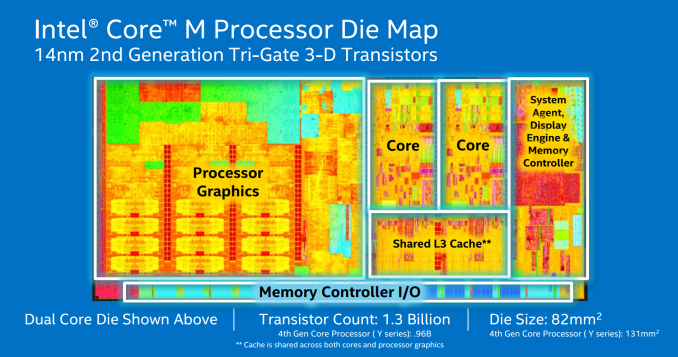
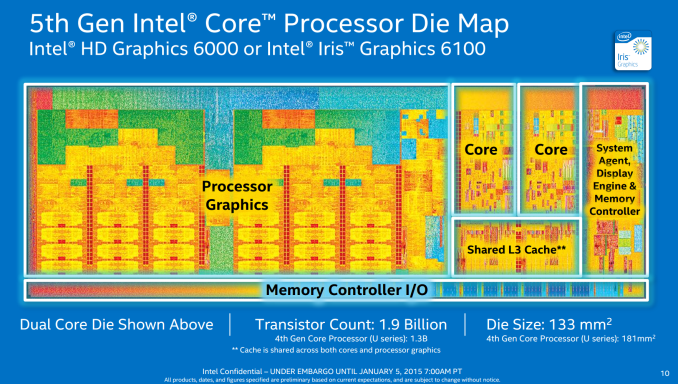
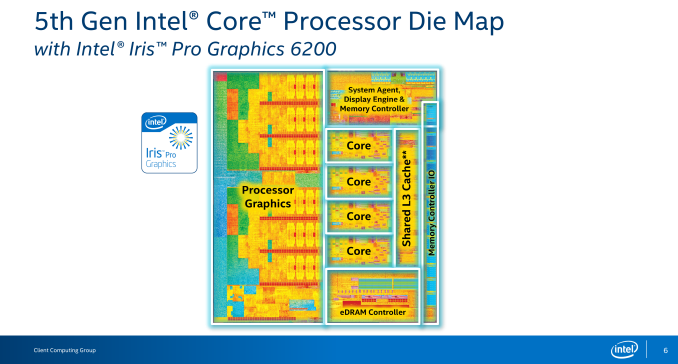
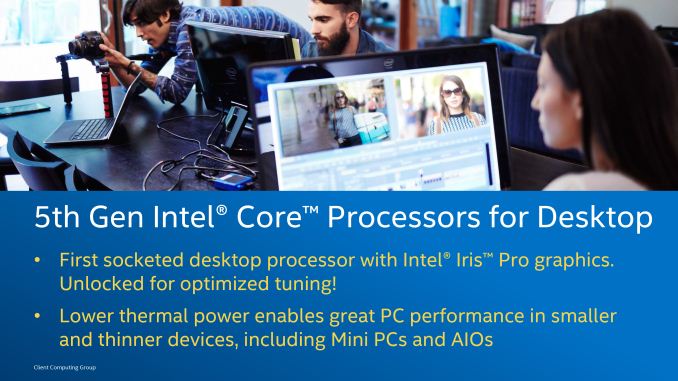
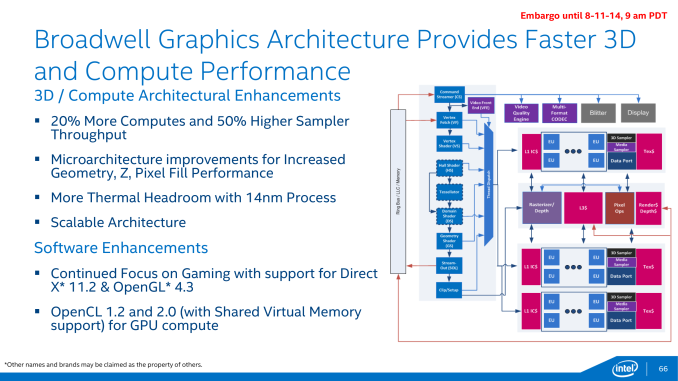








196 Comments
View All Comments
iTon - Saturday, June 6, 2015 - link
i've think AMD products best when used Mantle API. it can boost up to 30% than DirectX API. Otherwise 10% parts of AMD APU had TrueAudio DSP Processor. so it is not 100% CPU and GPUOxford Guy - Saturday, June 6, 2015 - link
Six APUs and not one FX chip in the charts.LAME
Oxford Guy - Saturday, June 6, 2015 - link
Heaven forbid someone might see that you can get a better Cinebench multithread score from a $100 8320E than from a pricey Intel...Oxford Guy - Saturday, June 6, 2015 - link
8320E with 1600 8-8-8-24 RAM at 1585 due to FSB, Cinebench 15 multithreadone core per module, 4.28 GHz, 399
one core per module, 5.02 GHz, 467
3.33 GHz, 540
one module disabled, 5 GHz, 590
3.8 GHz, 608
Intel i7-3770, 3.4 GHz, 662
4.17 GHz, 664
4.2 GHz, 675
4.28 GHz, 683
4.41 GHz, 703
4.56 GHz, 724
4.68 GHz, 743
4.78 GHz, 765
Intel 4770K at 4.4 GHz, 822
Clearly, an overclocked Intel will beat this chip in this test but if you have an Intel that can't be overclocked that may be a different story, depending on the stock clockspeed of the chip. Also, Cinebench is, as far as I know, a test that favors Intel since it relies heavily on FPU. None of the APUs are close to FX's performance so the lack of even one 8 thread FX in the charts is not good.
The single thread performance of FX is particularly weak but it can be improved quite a bit by setting the chip to 1 core per module because high clocks can be achieved with much less heat than when the full 8 threads are enabled. The downside is that multithread performance suffers (in tests like Cinebench that can use all 8 threads... perhaps not so much in programs that max out around 4).
single thread
A10-7850K, 92
4.2 GHz, 99
A10-6800K, 100
4.78 GHz, 111
5 GHz, 118
5.02 GHz, (one core per module), 120
5.21 GHz (only one module enabled), 122
5.17 GHz (one core per module), 122
Intel i7 3770, 3.4 GHz, 138
Intel i7 3930K, 3.3 GHz, 148
Oxford Guy - Saturday, June 6, 2015 - link
highest scoring APU in the multithread test:A10-6800K, 325
sireangelus - Saturday, June 6, 2015 - link
Anand, i'm going to heavly critizice your linux testing method.you go to great lengths to adjust and compensate for turbo modes, but on an ubuntu 11.04 it should completely ignore turbo modes since sandy bridge or does not even know what turbAdvances in the linux kernelo modes are, severely limiting both new intel and amd cpu. Also, the power profile is changed alongside the new intel pstate driver, that greatly improved performance under linux in respect to the past; also, new kernels are optimized for the eDram on the crystal well cpus. I suggest you start moving the whole testing platform to something more current or simply redo tests once a year with an updated kernel. You could use the phoromatic platform to automatize the procedure.
Ramon Zarat - Sunday, June 7, 2015 - link
Please add clock for clock comparison with older Intel CPU! Back to at least Sandy Bridge or even further if possible.ES_Revenge - Sunday, June 7, 2015 - link
So clearly Intel has now topped AMD's one remaining trump card--integrated graphics performance. Of course you're paying over 2x the cost for the privilege. One might argue that you're still getting a much better CPU at the same time, which is true, but most people just look at the absolute cost and the fact that the A10 is not all that bad a CPU.I think this becomes *much* more interesting if/when Intel starts producing *i3* CPUs with Iris Pro. Then it's really game over for AMD, unless Zen is something spectacular to allow them to catch up (or even get close) in CPU performance. AMD could also easily up the SPs in their APUs to something like ~1024 which would give them R7 265/PS4/GTX 750 Ti -class performance. The only problem is AMD hits another hitch there as they don't have the thermal/power envelope to do so given A10s can already throttle the CPU side when the GPU is in heavy use, in order to stay within TDP limits. AMD's lack of power and thermal efficiency with their GPUs (as competent as they are otherwise) also poses a serious problem in putting the same tech on an APU die.
Seems like AMD has to hit a homerun with both Zen for performance and their GPUs for efficiency in the coming year. However from everything we know about Fiji and the fact that the rest of the [GPU] lineup will be re-brands, it doesn't seem likely. Perhaps it's time to quit the CPU business, lol. Either that or release APUs with high-end graphics, boxed with CLC/AIO liquid coolers (or massive air coolers).
0ldman79 - Sunday, June 7, 2015 - link
I know it's a dead socket, but could we AM3+ users request a CPU be thrown in the mix?I keep reading, keep looking, the reviews look impressive, so I check the Anandtech Bench and my 6300 is still faster than the APU's.
In all honesty, that has to hurt AMD. Those of us that went with the "big boy socket" are still faster overall even though the APU has made big leaps in IPC and clock speed.
Fact is we're still out here and the only way to get faster across the board is to jump Intel.
ES_Revenge - Monday, June 8, 2015 - link
Well keep in mind your FX 6300 has two more cores (or one more module) and it has 8MB L3 compared to no L3 at all on the APUs. If they made a "6 core" APU with L3 on Kaveri/Godavari it would be faster.. at least until it starts hitting the TDP limits, lol. This of course is probably why there are no 6 or 8 CPU-core APUs--because they're already having problems with keeping TDP within limits with a 512SP GPU and 4-core CPU.